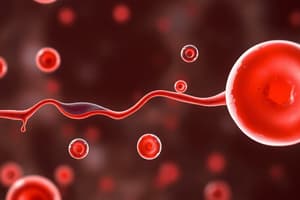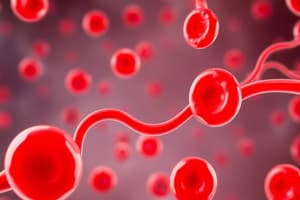Podcast
Questions and Answers
What is the primary function of erythrocytes?
What is the primary function of erythrocytes?
- Immune response
- Fluid regulation
- Gas transport (correct)
- Blood clotting
Platelets are a type of leukocyte involved in blood clotting.
Platelets are a type of leukocyte involved in blood clotting.
False (B)
What is the role of fibrin in the coagulation process?
What is the role of fibrin in the coagulation process?
Fibrin forms a mesh that helps stabilize the blood clot.
The ___ pathway is triggered by external trauma that leads to coagulation.
The ___ pathway is triggered by external trauma that leads to coagulation.
Match the components of the coagulation cascade to their functions:
Match the components of the coagulation cascade to their functions:
Which component of blood is primarily responsible for maintaining the osmotic gradient?
Which component of blood is primarily responsible for maintaining the osmotic gradient?
Vasoconstriction helps reduce blood loss after a blood vessel injury.
Vasoconstriction helps reduce blood loss after a blood vessel injury.
What is the primary function of leukocytes?
What is the primary function of leukocytes?
___ are undifferentiated cells that serve as precursors to all blood cells.
___ are undifferentiated cells that serve as precursors to all blood cells.
Which of the following substances is NOT typically found in plasma?
Which of the following substances is NOT typically found in plasma?
What is the primary function of platelets?
What is the primary function of platelets?
Vasoconstriction occurs as a response to decrease blood flow to an injured site.
Vasoconstriction occurs as a response to decrease blood flow to an injured site.
What stimulates endothelial cells to secrete von Willebrand factor (vWF)?
What stimulates endothelial cells to secrete von Willebrand factor (vWF)?
The coagulation cascade involves the activation of ________ factors.
The coagulation cascade involves the activation of ________ factors.
Match the following components with their functions:
Match the following components with their functions:
Which pathway primarily activates thrombin during the coagulation cascade?
Which pathway primarily activates thrombin during the coagulation cascade?
Platelet plug formation occurs before coagulation cascade activation.
Platelet plug formation occurs before coagulation cascade activation.
What is the result of platelet degranulation?
What is the result of platelet degranulation?
During hemostasis, _______ is released to enhance vasoconstriction.
During hemostasis, _______ is released to enhance vasoconstriction.
Match the stages of hemostasis:
Match the stages of hemostasis:
Which factor is essential for the aggregation of platelets at a site of injury?
Which factor is essential for the aggregation of platelets at a site of injury?
Endothelin is a paracrine signal that promotes vasodilation.
Endothelin is a paracrine signal that promotes vasodilation.
What is the role of EPO in red blood cell synthesis?
What is the role of EPO in red blood cell synthesis?
Platelets are produced from large ________ in the bone marrow.
Platelets are produced from large ________ in the bone marrow.
What is the primary result of the coagulation cascade?
What is the primary result of the coagulation cascade?
Fibrin is the main product formed at the end of the coagulation cascade.
Fibrin is the main product formed at the end of the coagulation cascade.
What enzyme dissolves fibrin during the process of fibrinolysis?
What enzyme dissolves fibrin during the process of fibrinolysis?
The process of breaking down fibrin is known as __________.
The process of breaking down fibrin is known as __________.
Match the following components with their roles in the coagulation process:
Match the following components with their roles in the coagulation process:
Which of the following mechanisms facilitates the initial response to vessel injury?
Which of the following mechanisms facilitates the initial response to vessel injury?
The extrinsic pathway is activated more slowly compared to the intrinsic pathway.
The extrinsic pathway is activated more slowly compared to the intrinsic pathway.
What is the role of vasoconstriction in the coagulation process?
What is the role of vasoconstriction in the coagulation process?
The formation of a __________ is essential for stopping bleeding.
The formation of a __________ is essential for stopping bleeding.
Match the pathways to their characteristics:
Match the pathways to their characteristics:
Which of the following best describes fibrin?
Which of the following best describes fibrin?
Platelets play a minor role in blood clot formation.
Platelets play a minor role in blood clot formation.
What determines the pathway (intrinsic or extrinsic) that is activated during clot formation?
What determines the pathway (intrinsic or extrinsic) that is activated during clot formation?
Fibrin is eventually removed from the wound site through __________.
Fibrin is eventually removed from the wound site through __________.
What is the ultimate role of the coagulation cascade?
What is the ultimate role of the coagulation cascade?
Flashcards are hidden until you start studying
Study Notes
Coagulation Cascade
- Fibrin is the end product of the coagulation cascade (formation of fibrin mesh)
- This fibrin mesh repairs damaged areas in the body
- Fibrinolysis is the dissolution of fibrin by plasmin
Hemostasis
- Hemostasis is the process of preventing blood loss within a damaged blood vessel
- Vasospasm is the vasoconstriction of vascular smooth muscle
- Decreases blood flow to the injured site
- Norepinephrine (NE) plays a role in pain reflex
- Endothelial cells secrete endothelin to aid in vasoconstriction
- Platelet adhesion causes a platelet release reaction, forming a platelet plug
- The coagulation cascade results in the formation of a blood clot
Platelet Release Reaction
- Damaged blood vessels expose collagen
- This stimulates endothelial cells to release von Willebrand Factor (vWF)
- vWF activates platelets and induces degranulation of the following
- ADP
- Serotonin
- Thromboxane A2
- Platelet factors:
- Enhance vasoconstriction
- Activate other platelets, eventually leading to the formation of a platelet plug
Coagulation Cascade
- Damaged areas expose collagen fibers and tissue factors
- This initiates a cascade of chemical reactions
- Inactive clotting factors are activated
Whole Blood: Plasma
- Plasma is the liquid portion of the blood
- Makes up about 90% of blood volume
- Consists primarily of water and dissolved substances
- Contains:
- Nutrients
- Metabolic wastes
- Gases
- Electrolytes
- Plasma proteins
- The osmolarity of plasma is ≈.300 Osm/300 mOsm
Plasma Proteins
- Plasma proteins serve a wide array of functions, including:
- Transport
- Blood clotting
- Coagulation
- Immunity
- Enzymes
- Albumin is a key player in maintaining an osmotic gradient between the tissues and bloodstream
- Serum is plasma with fibrinogen and other clotting proteins removed
Whole Blood: Cellular Elements
- Erythrocytes (Red Blood Cells) function in gas transport
- Leukocytes (White Blood Cells) function in immunity
- Platelets (Thrombocytes) function in blood clotting and coagulation
Hematopoiesis
- Pluripotent hematopoietic stem cells are undifferentiated cells that serve as precursors to all blood cells
- Important for stem cell research
- Progenitor cells are cells with numerous specific fates
- Give rise to specific blood cells
- Eventually leave the bone marrow and provide specific functions
- Example: White blood cells for immunity
Studying That Suits You
Use AI to generate personalized quizzes and flashcards to suit your learning preferences.



